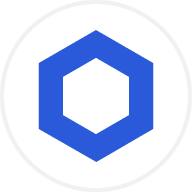How Chainlink is Revolutionizing DeFi and Crypto with Real-World Data Integration
Introduction: Chainlink’s Role in DeFi and Crypto
The decentralized finance (DeFi) ecosystem has revolutionized the crypto space by offering financial services without intermediaries. At the core of this transformation is Chainlink, a decentralized oracle network that bridges blockchain-based smart contracts with real-world data. By delivering secure, real-time data feeds, Chainlink has become a foundational pillar of DeFi infrastructure, enabling applications such as tokenized assets, stablecoins, and derivatives trading.
In this article, we’ll explore Chainlink’s pivotal role in driving DeFi adoption, its contributions to real-world asset (RWA) tokenization, and its partnerships with traditional financial institutions. We’ll also examine how Chainlink’s technological advancements position DeFi as a formidable competitor to traditional finance.
Regulatory Clarity: A Catalyst for DeFi Adoption
Regulatory clarity is a key driver of DeFi’s growth. Industry leaders, including Sergey Nazarov, co-founder of Chainlink, emphasize that clear regulations are essential for institutional adoption. With the right frameworks, DeFi adoption could grow from its current 30% to 100% by 2030.
Global Regulatory Developments
United States: Regulatory clarity in the U.S. is critical for unlocking institutional participation in DeFi. Clear guidelines could pave the way for widespread adoption.
Europe: The Markets in Crypto-Assets (MiCA) regulation is creating a structured framework for DeFi, fostering innovation and compliance.
UAE and Beyond: Regions like the UAE are emerging as global hubs for DeFi innovation, attracting institutional players and fostering growth.
Institutional Adoption of DeFi and Tokenized Assets
Institutional adoption of DeFi is accelerating as financial firms recognize the transformative potential of blockchain technology. Chainlink’s infrastructure is central to this shift, enabling the secure and efficient tokenization of real-world assets.
Key Trends in Institutional DeFi Adoption
Tokenized Assets: Institutions are leveraging blockchain to tokenize assets such as real estate, bonds, and equities, increasing their accessibility and liquidity.
Stablecoins: Stablecoins are becoming a cornerstone of DeFi, providing a reliable medium of exchange and store of value.
On-Chain Liquidity Pools: Financial institutions are exploring on-chain liquidity pools to enhance transparency and efficiency in trading.
Chainlink’s Infrastructure: The Backbone of DeFi
Chainlink’s decentralized oracle network is indispensable for DeFi applications. Its ability to provide secure, real-time data feeds ensures the reliability and functionality of smart contracts.
Key Features of Chainlink’s Infrastructure
Data Streams: Chainlink’s Data Streams deliver sub-second latency for real-world asset perpetuals, making DeFi competitive with centralized exchanges.
Cross-Chain Interoperability Protocol (CCIP): CCIP enables seamless communication between blockchain networks, enhancing DeFi’s scalability and usability.
Total Value Secured (TVS): Chainlink has secured over $100 billion in DeFi protocols, underscoring its critical role in the ecosystem.
Growth of DeFi Lending Protocols and TVL Metrics
DeFi lending protocols have experienced exponential growth, with the total value locked (TVL) increasing by 72% from $53 billion to $127 billion in 2025. This growth is fueled by innovations like tokenized assets and stablecoins, which expand the utility of DeFi platforms.
Why TVL Matters
TVL is a key metric for evaluating the health and adoption of DeFi protocols. Chainlink’s secure data feeds ensure the accuracy of TVL calculations, further solidifying its role in the ecosystem.
Real-World Asset Tokenization: Bridging TradFi and DeFi
Real-world asset (RWA) tokenization is one of the most promising applications of DeFi. By tokenizing assets such as real estate and commodities, DeFi platforms offer investors exposure to traditionally illiquid markets.
Chainlink’s Role in RWA Tokenization
Chainlink’s oracles provide the real-time data required to tokenize and trade RWAs securely. This capability is attracting institutional players and driving the integration of traditional finance (TradFi) with DeFi.
Partnerships with Traditional Financial Institutions
Chainlink’s partnerships with major institutions like Swift, Mastercard, and UBS highlight its growing influence in the financial world. These collaborations are bridging the gap between TradFi and DeFi, paving the way for mainstream adoption.
Real-World Use Cases
Tokenized Funds: Platforms like WisdomTree are utilizing Chainlink’s infrastructure to offer tokenized funds.
Derivatives Trading: Chainlink’s Data Streams enable advanced derivatives trading with sub-second data updates, enhancing market efficiency.
The Future of DeFi: Competing with Traditional Finance
DeFi is rapidly evolving, offering advanced financial services that rival traditional systems. Innovations like Chainlink’s Data Streams and CCIP are enhancing DeFi’s competitiveness by providing faster, more reliable data.
Key Advantages of DeFi
Transparency: Blockchain technology ensures transparency in financial transactions, reducing fraud and increasing trust.
Accessibility: DeFi platforms are open to anyone with an internet connection, democratizing access to financial services.
Efficiency: Smart contracts automate processes, reducing costs and increasing operational efficiency.
Conclusion: Chainlink’s Transformative Impact on DeFi and Crypto
Chainlink is not just a tool for DeFi; it is the backbone of the ecosystem. By providing secure, real-time data feeds and enabling advanced applications like RWA tokenization and cross-chain interoperability, Chainlink is driving the next wave of DeFi adoption. As regulatory clarity improves and institutional adoption accelerates, the future of DeFi looks brighter than ever.
Whether you’re a crypto enthusiast or a financial professional, understanding Chainlink’s role in DeFi is essential for navigating the evolving landscape of decentralized finance.
© 2025 OKX. Niniejszy artykuł może być powielany lub rozpowszechniany w całości, a także można wykorzystywać jego fragmenty liczące do 100 słów, pod warunkiem że takie wykorzystanie ma charakter niekomercyjny. Każde powielanie lub rozpowszechnianie całego artykułu musi również zawierać wyraźne stwierdzenie: „Ten artykuł jest © 2025 OKX i jest używany za zgodą”. Dozwolone fragmenty muszą odnosić się do nazwy artykułu i zawierać przypis, na przykład „Nazwa artykułu, [nazwisko autora, jeśli dotyczy], © 2025 OKX”. Niektóre treści mogą być generowane lub wspierane przez narzędzia sztucznej inteligencji (AI). Nie są dozwolone żadne prace pochodne ani inne sposoby wykorzystania tego artykułu.

